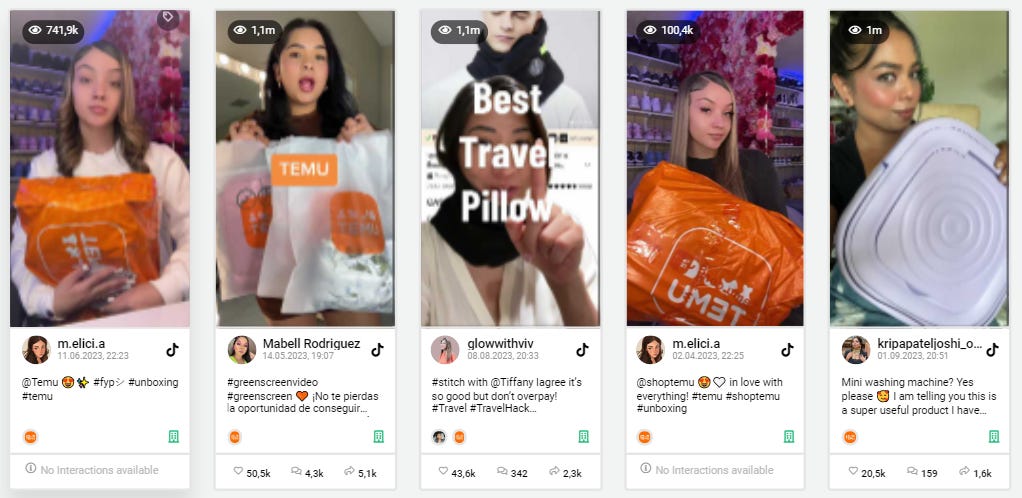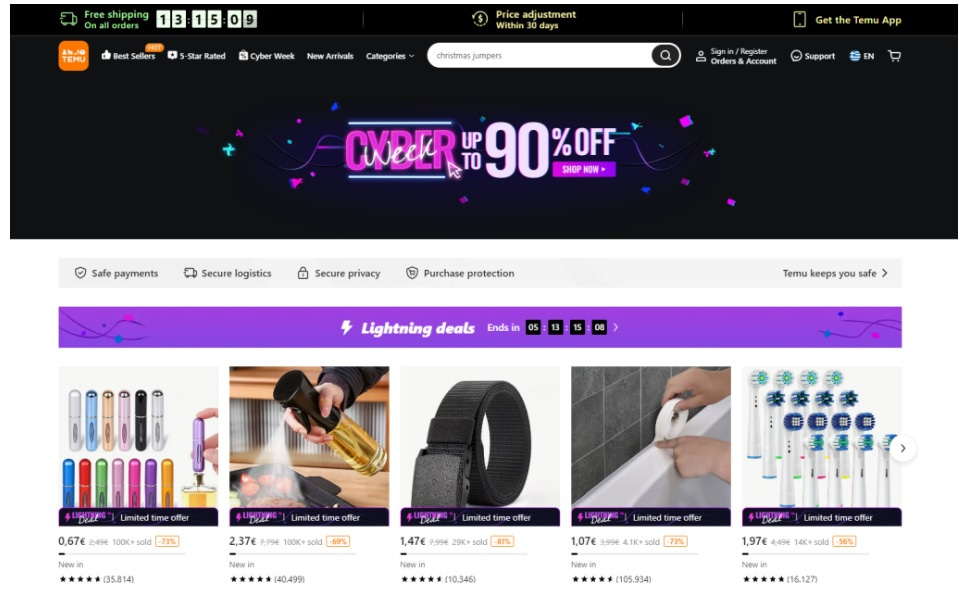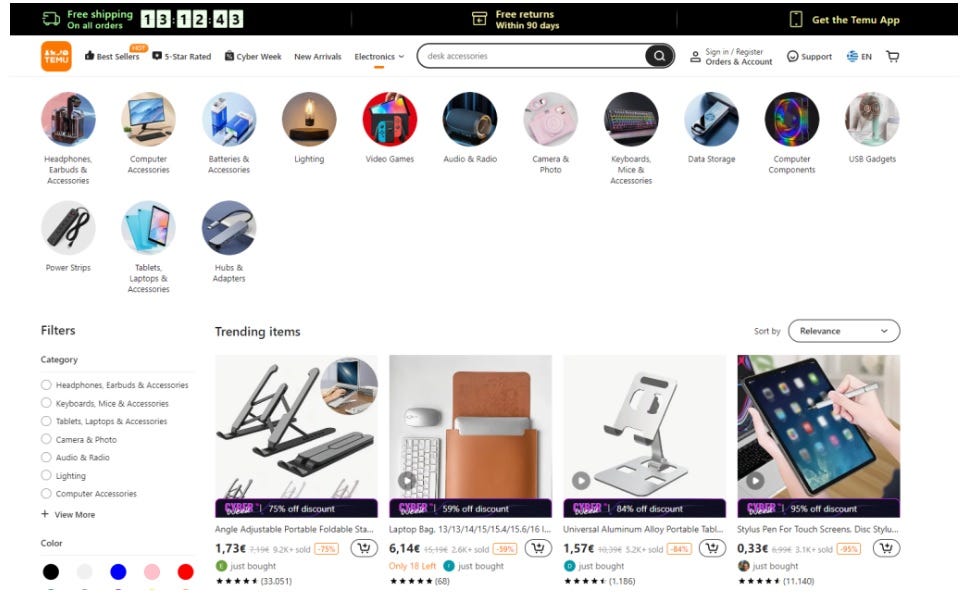What is the (PDD) Temu Story?
Last week Outside In went deep inside Pinduoduo’s (PDD) growth story here at:
The Pinduoduo (PDD) Growth Update 2023
Last week at Outside In we read up on The ‘No Buzz’ Alibaba Singles Day update and wondered who do we look for some bright growth and innovation Inspiration. And, almost instantly we got an answer in the form on Pinduoduo’s (PDD) 2023 Growth story here at:
While tracking the PDD story, we learnt that it also owns Temu – a fast-growing global discount shopping app. Temu was able to reach consumers in more than 40 countries since its launch but PDD describes its global business as “still in a very early stage”. Temu stands for “Team Up, Price Down”. The retailer partners with workshops to sell items at wholesale prices. Many Chinese manufacturers were wondering how to connect with overseas consumers, and Temu gave them the opportunity. As part of that study, we found out that part of the meteoric PDD Growth ascent in 2023 stemmed from Temu. In just over a year, it has overtaken Shein in sales and is now regarded as one of the more disruptive forces in global e-commerce. Temu – which follows the same strategy of cut-rate pricing employed by Shein as well as PDD’s own Pinduoduo — has expanded into scores of countries.
But what is the (PDD) Temu Story? No one seems to know… Outside In goes for a deep dive!
Temu (US) – Drives PDD Growth in 2023…
Launched in the U.S. in September 2022, Temu was PDD’s first major push outside of China and the app quickly found success among budget-conscious consumers. In just a few weeks, Temu has risen to the top of app stores and subsequently expanded rapidly across countries such as Australia, New Zealand, France, Italy, Germany, the Netherlands, Spain, and the U.K.
As of last month, Temu accounted for nearly 17% of market share in the United States within the discount stores categories, according to data analytics firm Earnest Analytics. That compares to 8% for the dollar chain Five Below, 43% for Dollar General and 28% for Dollar Tree. It has quickly become popular through its use of social-media influencers to tout its merchandise as better and more affordable than traditional stores. Its low prices on household goods and consumer staples make it more of a threat to brick-and-mortar discounters like the dollar stores than other online marketplaces
Temu sells apparel including $12 dresses and $20 sneakers, while also offering similar holiday decor, storage containers and toys as dollar stores. Analysts expect it to generate more than $16 billion in revenue this year as it expands internationally. It has the advantage of novelty and excitement that is hard to re-create for staid low-end discount retail brands. It uses a network of China-based manufacturers of cheap personal electronics, clothes and home goods. Factories and merchants on Temu send merchandise directly to Temu shoppers, using a trade exemption that allows shipments under $800 to enter the U.S. duty-free. With their 'shop like a billionaire' slogan, it has mastered gamification and rewards to make online shopping fun, easy, and cheaper than the dollar stores. With that quick snapshot, let’s explore the Key Success Factors driving its furious growth below…
1) First, the Impressive Growth Numbers
Consider these statistics that make Temu a compelling “Growth” story to track:
Temu’s revenue grew from $3 million in September 2022 to $635 million in May 2023 (Statista)
Temu’s customer count grew from 5.8 million users in October 2022 to more than 100 million in April 2023 (Bloomberg)
Its hashtag on TikTok has more than 300 million views, making it a popular location for connecting with potential customers
Temu has become the fourth-most popular eCommerce marketplace (MobiLoud)
2) Unique Product Assortment and Omnichannel Shopping Entertainment
Temu’s product strategy is simple — offer affordable products from Chinese manufacturers and wholesalers directly to consumers at the wholesale price. Its products aren’t limited to a specific category and it doesn’t specialize in clothing, books, or housewares. Shoppers can buy anything from clothing to small kitchen appliances. It offers categories similar to other online retailers and offline department stores, appealing to shoppers who want a one-stop site for whatever they need
It supports its marketing campaigns, with unique assortment and omnichannel engagement strategy – featuring Digital as well as TV Advertising. It also makes it fun to get deals, adding a wheel of discounts and other prizes within the app, which allows shoppers to press their luck and win deals on already-affordable merchandise. This really connects well with young buyers by offering them the merchandise they want and making the shopping experience fun
By playing games like Fishland, Coin Spin, Card Flip, and others, customers can win rewards that ultimately lead to more time spent on the site and a dopamine rush from winning free items
3) Low Pricing Focus
Check its latest ‘Shop like a Billionaire Campaign’ Video here:
Much of Temu proposition revolves around low prices. Temu’s slogan, “Shop like a billionaire” implies that customers can stretch their money further because they get steep discounts. Shoppers can find numerous items for less than $10, although the website does require a minimum order size of $15 to check out. According to Temu, this minimum makes it less costly to fulfill orders and discourages people from ordering merchandise to test it out and then returning it. The minimum order is also aiming to increase each customer’s lifetime value
It also offers a ‘Group Buying Model’, which is popular in Asian countries. This model is a process in which an item is offered at a specific price, assuming enough people will buy it
4) Influential ‘Digital-first’ Marketing Strategy
Temu’s customer base consists of young, price-conscious shoppers. As of 2023, people between the ages of 25 and 34 made up the bulk of Temu’s website visitors, followed closely by 35- to 44-year-olds. The audience is split evenly between males and females, with males accounting for 51.54% of the site’s traffic. It appeals to a target audience that enjoys video games, news, and online shopping
The key lies in social commerce, influential marketing, and heavily personalized targeted ads. These ads, coupled with an effective loyalty program, have helped the company achieve exponential growth. It had also used techniques such as affiliate marketing and gamification to grow. Its marketing strategy involves targeted ads in places where its users will see them to appeal to its audience. The company partners with influencers, who make videos about their shopping hauls and post them across social media. The brand also runs promoted social media posts on TikTok, Instagram, and other popular platforms. Since the company offers a wide range of products, it can target customers based on their interests and search engine history
Meme-based Content
The brand tends to engage its followers with relatable, meme-based content. The tone is light-hearted and humorous, poking fun at everyday situations
Instagram Influencer Strategy
In the last 12 months, Temu was mentioned by 1.5k creators in 3.7k posts. The brand’s creators often post educational, how-to content, like makeup tutorials. They often combine this approach with topical trends, like Barbie. The brand works predominantly with micro influencers. These mid-size influencers with 10k-100k followers make up 54% of Temu’s collaborations. 37% of the brands collaborations are with macro influencers (100k - 1M followers) and only 5% are with mega influencers (over 1M followers). This seems to be a sensible strategy as smaller accounts are often more relatable and authentic than mega celebrity influencers, and the engagement rate tends to be higher
TikTok Influencer Strategy
Over the last 12 months on TikTok, 158 creators mentioned Temu in 297 Postings. TikTok videos from the brand's creators drive 82.3k views on average, and can reach a potential audience of 248.6m. The TikTok reels creators share on behalf of the brand is often unboxing videos, or creators showing how happy they are with their hauls. Occasionally they present specific products. It’s not just fashion and beauty. They share all kinds of products, from cat beds to travel pillows and mini washing machines
This reflects a sense of loyalty, which seems to be a sound strategy as multiple mentions by an influencer typically, has a more substantial impact on their audience than just one
Influencer Leaderboard
Temu regularly promotes their influencer marketing program and encourages customers to sign up. They offer $300 seeding balance and up to $100,000 affiliate cash per month. They call out top-performing influencers with a leaderboard and share how much money other influencers have earned
5) Effective Distribution and Shipping
Temu works with many carriers, including the U.S. Postal Service, UPS, and FedEx. Distribution depends on the item. Some items are shipped to customers directly from the manufacturer. In these cases, shipping can take as long as 25 days. However, other items are available at a Temu distribution center, allowing customers to receive them in three to five days. The company’s warehouse is in California, housing frequently purchased items for American shoppers. Temu offers free shipping on most orders, and free express shipping for all orders over $129. This differs from many online marketplaces, for which shipping rates are set by sellers
6) Incentive-driven Word-of-Mouth Referral Programs
Temu's successful referral program incentivizes customers to recommend the brand to their friends and connections. Word-of-mouth referrals are probably a powerful and free way to expand its customer base, as people are more inclined to believe their friends than paid advertising
7) Finally, a Solid Online Shopping Experience
Home Page – Lightning Deals, Easy Navigation, Prominent Banners, Policy Clarity
Category and Product Pages – Smooth Navigation, Organized Category Trees, Easy Filters, Starred-Product Reviews, Product Videos to show they Work
Checkout – Seamless Process, Easy Navigation, Smooth Discount/Payment Selections
In Conclusion
Temu has launched and grown successfully since 2022 and through 2023. These are potential future strategies that it could pursue going forward and strengthen its proposition for its customers: Private Labels, Heavier tilt towards (In-App) Gamification, away from Social Media and (Popular) US Brand Partnerships. Looks like we indeed have a new “Growth” trailblazer in Temu to track…in 2024 and beyond…
References and Sources
1) Fortune on Alibaba’s Reversal, PDD’s Growth and Rise of Temu: https://fortune.com/2023/11/30/alibaba-market-value-below-pdd-china/
2) Temu Drawing Shoppers from US Dollar Stores: https://www.reuters.com/business/retail-consumer/chinese-e-commerce-platform-temu-drawing-shoppers-us-dollar-stores-data-2023-12-06/
3) ContactPigeon Temu Marketing Strategy: https://blog.contactpigeon.com/temu-marketing-strategy
4) StoryClash Temu Marketing Strategy: https://www.storyclash.com/blog/en/temu-marketing-strategy/
5) EcommerceDB Temu Business Model 2023: https://ecommercedb.com/insights/temus-strategy-to-compete-in-the-realm-of-ultra-fast-ecommerce/4439













